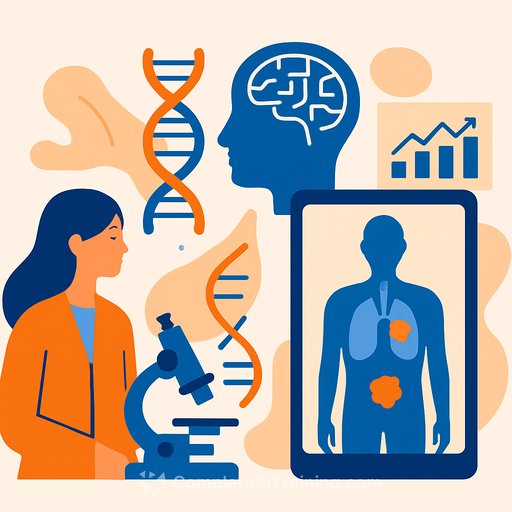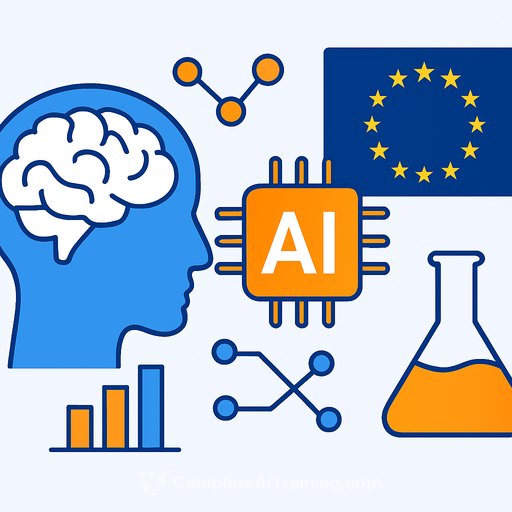Can AI Predict Cancer? New Model Uses Genomics to Simulate Tumors
Date: July 27, 2025
Source: University of Maryland School of Medicine
Summary
Scientists at the University of Maryland School of Medicine have created software that uses patient genomics combined with a novel plain-language “hypothesis grammar” to simulate how cells behave over time. This approach enables researchers to digitally model cancer growth, immune system responses, and potential treatment outcomes on a patient-specific basis.
Predicting Cancer Like Weather
The new method draws parallels to weather forecasting by predicting cellular activity in tissues over time. By integrating genomics data with computational modeling, the software can simulate how cells communicate and evolve—key factors in cancer progression.
This project, led by the Institute for Genome Sciences (IGS) at UMSOM and published in the journal Cell, represents a collaboration between software developers, laboratory researchers, and clinical scientists. The goal is to create a “digital twin” of cancer patients, providing predictive insight to guide personalized treatment strategies.
From Single Snapshots to Dynamic Simulations
Traditional genomics offers static snapshots of cellular environments. According to Jeanette Johnson, PhD, co-first author and postdoctoral fellow at IGS, this new model addresses the challenge of predicting cancer, which depends on complex interactions between cancer cells and the immune system—an individualized process that standard data alone cannot fully capture.
Hypothesis Grammar: Bridging Biology and Computation
A key innovation is the use of a plain-language “hypothesis grammar” developed by Paul Macklin, PhD, at Indiana University. This grammar translates biological behaviors into simple English sentences that computers can use to build simulations of multicellular systems. It facilitates communication across disciplines, allowing biologists and computational scientists to collaborate effectively.
Daniel Bergman, PhD, co-leading author and scientist at IGS, highlights how this grammar enables researchers to build models that reflect the complexity of cancer and immune interactions.
Modeling Breast and Pancreatic Cancer
Using spatial transcriptomics and genomic data from patient samples, the team modeled breast cancer scenarios where the immune system inadvertently promotes tumor growth and invasion. They also simulated a pancreatic cancer immunotherapy trial, demonstrating varied responses among virtual patients based on their cellular ecosystems.
Pancreatic tumors are often surrounded by fibroblasts, which complicate treatment. The model tracked how fibroblasts communicate with tumor cells, mapping tumor progression and invasion in patient tissue samples.
Applications and Advantages
Dr. Johnson explains that these models can be constructed and refined using both lab and human genomic data, offering a “sandbox” to test hypotheses about immune behavior without risk or cost to patients.
Elana J. Fertig, PhD, Director of IGS, draws on her background in weather prediction to apply similar principles in biology. She emphasizes that this approach reveals many biological rules still unknown and provides a virtual lab environment for experimenting with cellular behaviors in silico.
Collaboration and Accessibility
The project involved clinical collaborators from Johns Hopkins University and Oregon Health Sciences University, with funding from the National Foundation for Cancer Research. The hypothesis grammar is open source, promoting wider adoption and standardization in computational modeling.
Genevieve Stein-O'Brien, PhD, from Johns Hopkins, applied this framework to neuroscience, simulating brain layer development, demonstrating the model’s versatility beyond cancer research.
Mark T. Gladwin, MD, Dean of UMSOM, notes the potential for digital twins and virtual clinical trials to advance cancer treatment and other medical fields.
Looking Ahead
Senior authors Paul Macklin, Genevieve Stein-O'Brien, and Elana Fertig continue efforts to integrate this software with genomics data for automatic model formulation, supported by the National Cancer Institute’s Informatics Technology in Cancer Research Consortium. Funding also comes from several cancer research foundations and state programs.
This approach sets a foundation for more precise, patient-specific cancer research and treatment planning, with promising applications in other areas of biomedical science.
Your membership also unlocks:






